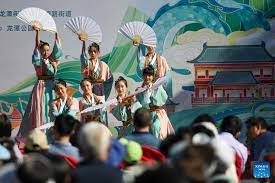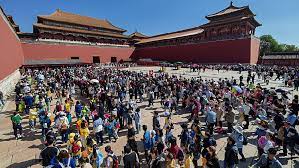Beijing sees booming holiday consumption

BEIJING– Customer flow trackers in 60 key commercial districts in Beijing recorded 20.68 million entries over this year’s Dragon Boat Festival holiday, up 76.8 percent year on year, according to the Beijing Municipal Commerce Bureau.
Beijing saw a vibrant and orderly consumption market over the holiday, which lasted from Thursday to Saturday. Statistics show that monitored enterprises in Beijing, including department stores, supermarkets, specialty stores, and businesses in the catering and e-commerce sectors, achieved total sales of 2.47 billion yuan (about 344 million U.S. dollars), with the number of physical-store businesses up 29 percent year on year.

The new Jingxi Joy City in Beijing’s Shijingshan District attracted substantial numbers of customers over the holiday. The urban commercial and office complex brings more than 200 brands to the city, including over 60 stores opening in the region for the first time and more than 40 flagship stores and customization workshops.
“I initially planned to visit Jingxi Joy City when the weather was cooler, and assumed there might be fewer people at night. However, I was surprised that there was still a crowd. Jingxi Joy City has become another good place to go,” Beijing resident Peng Feng said.
Both established commercial districts and trendy attractions were bustling with consumption activities during the holiday. The night market also contributed to the vitality, with restaurants, barbecue shops and bars filled with customers.

Multiple business districts, such as Huaxi LIVE, Hopson One Mall and Shine Hills, launched late-night food streets for the occasion. China Central Place introduced many new dining and wine brands, such as Jing-A Brewing Co., creating a vibrant atmosphere.
According to China UnionPay’s business data, the consumption of physical commodities at night increased by 44 percent year on year. Dining and services consumption at night saw respective year-on-year increases of 65.9 percent and 32.3 percent.
The culture and tourism market in Beijing also boosted customer flows through various activities. On the first day of the holiday, a Dragon Boat Festival garden party was held at the Beijing Garden Expo Park. Visitors participated in folk activities on the pedestrian street, such as making colorful ropes, dough figurines and fragrant bags.
“There are many experience projects this year, and staff have also brought in customs such as forehead painting. While having fun, I also gained knowledge,” said a visitor surnamed Xu, who also enjoyed opera performances and ethnic costume displays during the celebrations.
Despite the scorching summer heat, major scenic locations received numerous enthusiastic tourists. A total of 639 travel agencies in Beijing organized 7,616 domestic tour groups, serving 180,200 group tourists, an increase of 138 percent from the same period in 2019. Tickets quickly sold out for tourist attractions such as the Forbidden City, Prince Gong’s Mansion and the Beijing Planetarium.
During the holiday, a total of 129 theaters in Beijing staged 203 plays, with a total of 708 performances, attracting over 200,000 audience members and generating a ticket revenue of nearly 60 million yuan. The number of performances, audience attendance and ticket revenues all saw significant increases compared to the Dragon Boat Festival holiday of 2019.
The demand for cultural experiences and leisure activities was fully satisfied during this year’s Dragon Boat Festival holiday. The number of tourists and total tourism revenue exceeded the figures from the same period in 2019, indicating a recovery trend in the cultural and tourism market, according to an official of the Beijing Municipal Bureau of Culture and Tourism.





